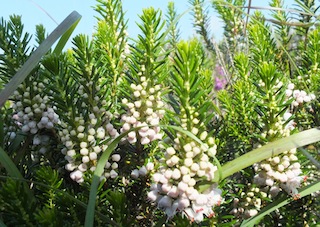 The lovely Cornish Heath, in Great Britain only found growing naturally on the serpentine rocks of The Lizard, starts to flower in mid-summer.
The lovely Cornish Heath, in Great Britain only found growing naturally on the serpentine rocks of The Lizard, starts to flower in mid-summer.
Photo: Amanda Scott
Scientific name: Erica vagans
Cornish name: Grig is the word for heather generally, and griglan means heathland or bushy heather
Other names: Wandering Heath
Conservation status: The Vascular Plant Red Data List for Great Britain, Nationally Rare; it is separately protected in Northern Ireland.
 In Great Britain, Cornish Heath, a member of the Heath family (Ericaceae) is now only found on The Lizard; it is also found in Co. Fermanagh in Northern Ireland, where it may have been introduced in the prehistoric era. Classified as nationally rare, it is however locally abundant in many locations on The Lizard, or grows alongside plants such as Bell Heather (Erica cinerea) and Gorse (Ulex spp.), or with ‘tall heath’ vegetation in other locations such as Purple Moor-grass (Molinia caerulea), Cross-leaved Heath (Erica tetralix) and Black Bog-rush (Schoenus nigricans)
In Great Britain, Cornish Heath, a member of the Heath family (Ericaceae) is now only found on The Lizard; it is also found in Co. Fermanagh in Northern Ireland, where it may have been introduced in the prehistoric era. Classified as nationally rare, it is however locally abundant in many locations on The Lizard, or grows alongside plants such as Bell Heather (Erica cinerea) and Gorse (Ulex spp.), or with ‘tall heath’ vegetation in other locations such as Purple Moor-grass (Molinia caerulea), Cross-leaved Heath (Erica tetralix) and Black Bog-rush (Schoenus nigricans)
Its long straight stems can reach up to 80 cm tall, with the linear leaves arranged in whorls. The distinctive racemes of flowers, appearing from July to August, are pale pink or lilac to white (the colour can vary): at first glance it looks as if they have a purple-coloured edge, but closer inspection shows that this is the protruding dark brown-purple anthers.
Cornish Heath is a plant of dry heathland. Seldom found close to the coast as it is intolerant of salt spray, it is able to withstand drought better than other heath species. It is also very tolerant of alkaline soils, and is therefore almost exclusively found on soils overlying the serpentine of The Lizard.
Did you know…?
…The species name of vagans means ‘wandering’, in the sense of having a wide distribution. Cornish Heath in fact severely declined in distribution in the twentieth century, but is now protected in its remaining locations
…Its tolerance of alkaline soils means that Erica vagans has been much cultivated for use in gardens, with many cultivars available
More information and references:
Bates, R. and Scolding, B., 2002. Wild Flowers of The Lizard. Cornwall County Council, Cornwall.
Rose, F. and O’Reilly, C., 2006. The Wild Flower Key, 2nd edition. Frederick Warne, London.
Stace, C., 2010. New Flora of the British Isles, 3rd edition. Cambridge University Press, Cambridge.
Published: July 2013
Author: Amanda Scott
Photos: Amanda Scott

